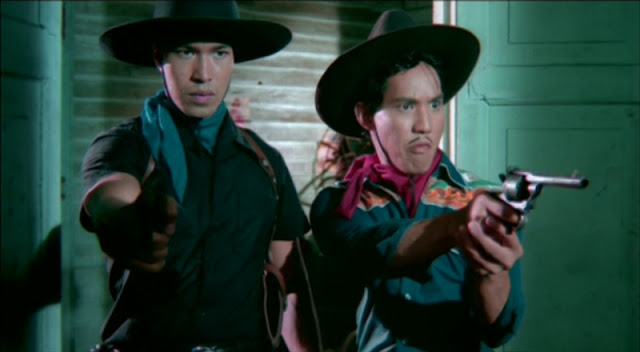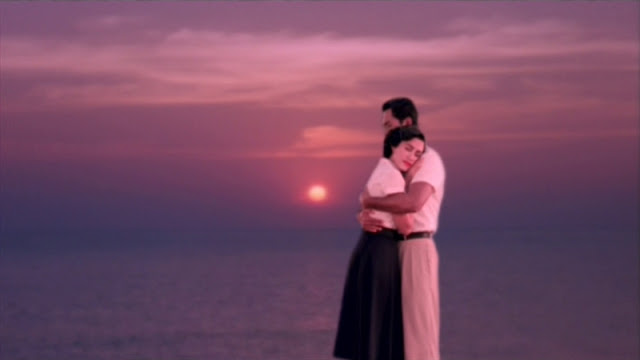(2000) Written and directed by Wisit Sasanatieng; Starring: Chartchai Ngamsan, Stella
Malucchi, Supakorn Kitsuwon, Suwinit Panjamawat, Arawat Ruangvuth and Sombat
Metanee; Available on DVD
Rating: ****
The following review is part of the Foreign Western Blogathon, hosted by Debbie V. from Moon in Gemini, looking at a traditionally American genre through a different lens.
“The movie harks back to traditional knowledge, like old herbs we used to boil and drink, which now come in capsules. Like our film, we mixed it with modern film language for a current audience. If it was just an old movie, nobody would be interested. We just borrowed its form, techniques, and combined it with contemporary film language.” – Wisit Sasanatieng
Over the years, many talented foreign filmmakers have
tinkered with a genre that was once regarded as the exclusive domain of Hollywood,
to create something simultaneously familiar and completely new. A successful
reinterpretation of the Western requires more than simply changing the location
or shuffling the actors, but changing the cultural perspective, by utilizing
familiar conventions as a launching point rather than a destination. One such
example is the Thai Western mash-up, Tears of the Black Tiger, a melodrama
about star-crossed lovers that infuses the familiar tropes of American Westerns
with Thai sensibilities. Setting his film in post-WW II Thailand, writer/director
Wisit Sasanatieng blends old-fashioned and contemporary elements, resulting in something
uniquely classic and post-modern.
Dum, aka “Black Tiger” (Chartchai Ngamsan), the film’s antihero protagonist, lives outside the law yet adheres to a strict internal moral code. He works as an enforcer for the ruthless crime boss, Fai (Sombat Metanee), becoming his right-hand man (much to the irritation of fellow outlaw Mahesuan, played by Supakorn Kitsuwon, who formerly occupied that vaunted position). In a flashback, we witness how he meets the love of his life, Rumpoey, the high-born daughter of a local governor. The young girl goads peasant boy Dum into taking her out on a boat, where they discover a sala (a sort of Thai gazebo) floating amidst the lily pads. At that moment, they vow to make this their meeting place. Events take a near-tragic turn when they encounter a trio of bullies, and she nearly drowns in the ensuing scuffle. When he eventually returns home with her near-lifeless body, he’s severely punished by his father (who works for her father). Flash forward 10 years, and the adult Rumpoey (played by Italian-Colombian actress Stella Malucchi) is betrothed to Police Captain Kumjorn (Arawat Ruangvuth). Instead of sharing his joy, she only feels empty, as her heart belongs to Dum.
Contrasting the rather conventional story of lovers
separated by rigid class roles, is a delightfully unconventional pastiche of
styles. Sasanatieng draws as much upon glossy Technicolor Hollywood cowboy
dramas as gritty “spaghetti” Westerns to play in his cinematic sandbox. One
scene illustrates via instant replay how Dum is the quickest gun in Thailand.
He’s so skillful that he intentionally aims his pistol, so the bullet ricochets
off the interior of a cabin to hit his mark. In another scene, he squares off
against a rival gunfighter, accompanied by a surreal painted background.
Tears of the Black Tiger owes much of its distinctive
look to post-production visual trickery. The footage was initially shot on 35
mm black-and-white film, transferred to tape for digital editing (including the
addition of color), and finally transferred back to film. Many of the colorful
scenes feature vivid pinks, reds and greens, while in one sequence, set at a
train station, the hues are purposely muted, with digital scratches applied to mimic
archival footage. In another scene, when Rumpoey and Dum are seated in the back
seat of her chauffeur-driven car, the foreground remains in color, while the
projected background through the car windows is in black and white.
Sasanatieng frequently plays with the artifice of motion pictures, favoring striking visual compositions and willfully anachronistic depictions over any pretense of realism. While the bandits ride horses and dress in traditional (albeit stylized) cowboy garb, the film remains firmly rooted in the mid-20th century, as they fight the police with machine guns, bazookas and hand grenades. The soundtrack is also a mix of old and new, filled with musical interludes (consisting of vintage Thai pop songs alongside new interpretations by contemporary artists). Tears of the Black Tiger at once celebrates the joy of filmmaking while a streak of a melancholic fatalism runs throughout. According to Sasanatieng, “Thais believe that destiny leads us down the right path,” which ultimately informs the inevitable path the plot must follow. It’s a self-aware exercise in style steeped in Eastern and Western tradition, making this an unforgettable experience.







Wow, this looks AMAZING, I am definitely going to seek it out. Post-modern + Western + melodrama = like it was made for me! Thanks so much for bringing it to the blogathon!
ReplyDeleteThanks, Debbie! It's truly one of the most unique Westerns I've ever seen. I can't recommend it enough. And thanks again for hosting such a cool blogathon!
DeleteThis looks fun! I agree with you about no one culture having claim to westerns--it's interesting to see how different people approach them.
ReplyDeleteIt's such a visually playful film. So much fun. I love the Thai spin on the tried and true Western.
DeleteIntriguing review, Barry!
ReplyDeleteI've never heard of tears of the black tiger, but it definitely sounds and looks visually arresting!
Thanks, John! I can't recommend it enough. And in case you're wondering, the DVD even has an English Language track. ;)
Delete